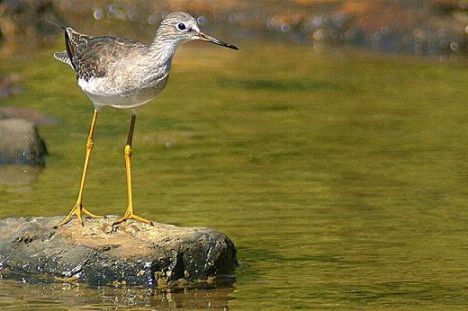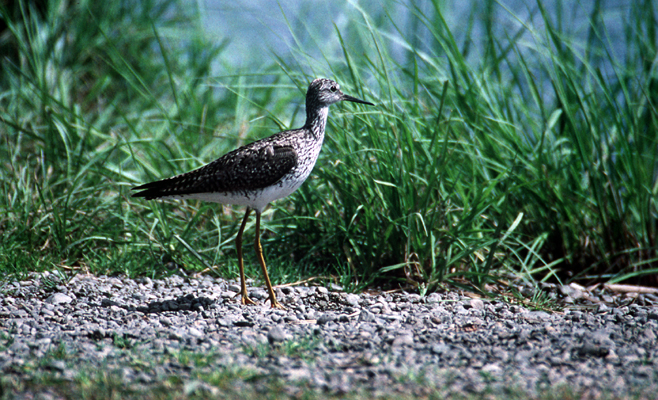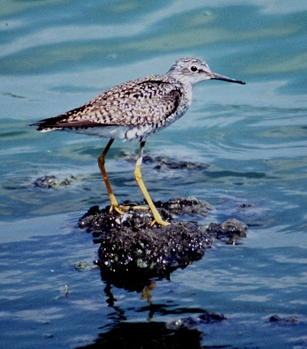|
Lesser Yellowlegs Tringa flavipes Patiamarillo Menor,
|
 |
|
Photo: G. Beaton
|
|
Lesser Yellowlegs Tringa flavipes Patiamarillo Menor,
|
 |
|
Photo: G. Beaton
|
|
IDENTIFICATION: A gray-backed shorebird, with long yellow legs. Its bill is shorter and thinner than the larger Greater Yellowlegs. Length: 23-25 cm.; weight: 67-94 g. VOICE: The call is a repeated series of single or double notes, sometimes more. Usually the number of notes is fewer and on a higher pitch than the call of the Greater Yellowlegs. Audio (M. Oberle). HABITAT: Marshes, mudflats, and edges of ponds. HABITS: Plucks prey off the surface of mudflats and will wade into shallow water to look for food on the surface. Eats insects, worms, snails, small fish and crustaceans. It flocks with other shorebird species, such as Black-necked Stilts or Greater Yellowlegs, but sometimes defends choice feeding areas from other yellowlegs. It rocks its body when alarmed. On its breeding grounds in North America, it builds a simple nest on the ground in dense vegetation. Both sexes incubate the eggs for about three weeks. Young leave the nest soon after hatching, and the parents lead them to feeding sites. Chicks fledge about 22-23 days after hatching. STATUS AND CONSERVATION: A common winter resident in Puerto Rico, usually more common than the Greater Yellowlegs. RANGE: Breeds from central Alaska and northwestern Canada to the western side of Hudson Bay. Winters along the southern coast of North America, through the West Indies and Central America to southern South America. In Puerto Rico, a regular place to find this species is the Cabo Rojo salt flats.
TAXONOMY: CHARADRIIFORMES; SCOLOPACIDAE; Scolopacinae |
 |
|
Photo: A. Sánchez Muñoz
|
 |
|
Photo: G. Beaton
|
 |
|
Photo: G. Beaton
|
|
References Bent, A.C. 1927. Life histories of North American shore birds, part 1. Smithsonian Instit. U.S. National Museum Bull. 142. (Reprinted by Dover Press, NY, 1962). Collazo, J.A., B.A. Harrington, J. Grear, and J.A. Colón. 1995. Abundance and distribution of shorebirds at the Cabo Rojo salt flats, Puerto Rico. J. Field Ornithol. 66:424-438. del Hoyo, J., A. Elliott, and J. Sargatal, eds. 1996. Handbook of Birds of the World, Vol. 3. Hoatzin to Auks. Lynx Edicions, Barcelona. Ehrlich, P.R., D.S. Dobkin, and D. Wheye. 1988. The birder’s handbook: a field guide to the natural history of North American birds. Simon and Schuster/Fireside, NY. Hayman, P., J. Marchant, and T. Prater. 1986. Shorebirds: an identification guide. Houghton Mifflin, Boston. Paulson, D. 1993. Shorebirds of the Pacific Northwest. Univ Washington, Seattle. Raffaele, H.A. 1989. A guide to the birds of Puerto Rico and the Virgin Islands. Princeton. Raffaele, H.A. 1989. Una guía a las aves de Puerto Rico y las Islas Vírgenes. Publishing Resources, Inc., Santurce, PR. Raffaele, H.A., J.W. Wiley, O.H. Garrido, A.R. Keith, and J.I. Raffaele. 1998. Guide to the birds of the West Indies. Princeton. Saliva, J.E. 1994. Vieques y su fauna: Vieques wildlife manual. U.S. Fish & Wildlife Service, Boquerón, PR. Tibbitts, T.L. and W. Moskoff. 1999. Lesser Yellowlegs (Tringa flavipes). No. 427 in The birds of North America (A. Poole and F. Gill, eds.). The birds of North America, Inc., Philadelphia, PA. Wunderle, J.M., Jr., R.B. Waide, and J. Fernández. 1989. Seasonal abundance of shorebirds in the Jobos estuary in southern Puerto Rico. J. Field Ornithol. 60:329-339. Lesser Yellowlegs, Spanish text Next related species in taxonomic order Previous related species in taxonomic order |